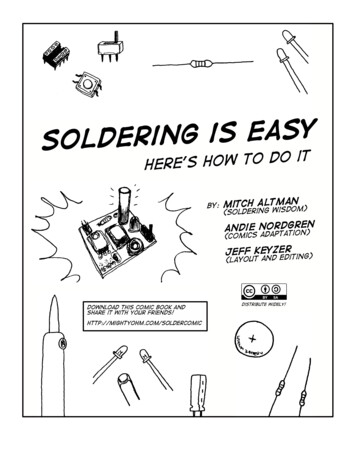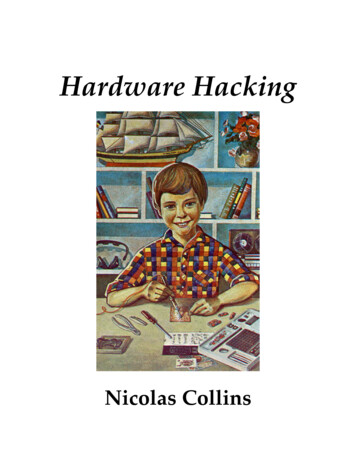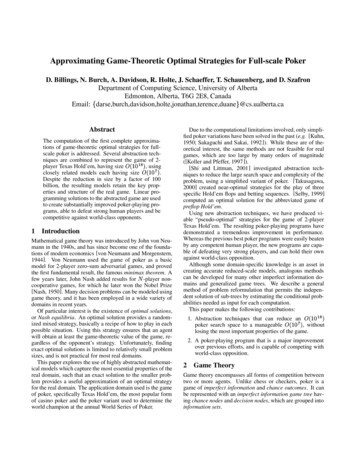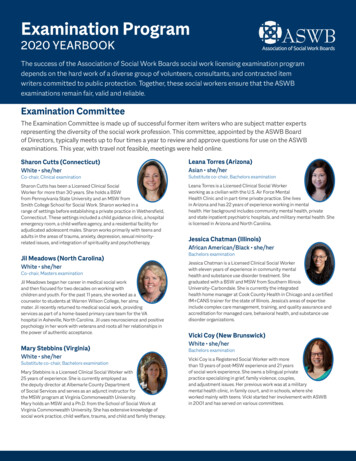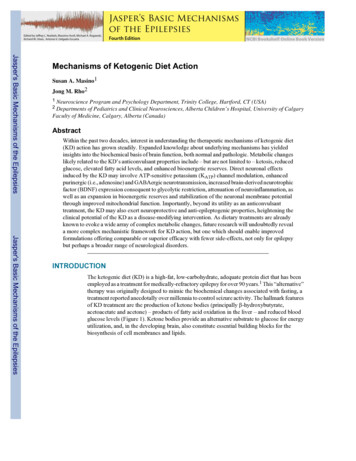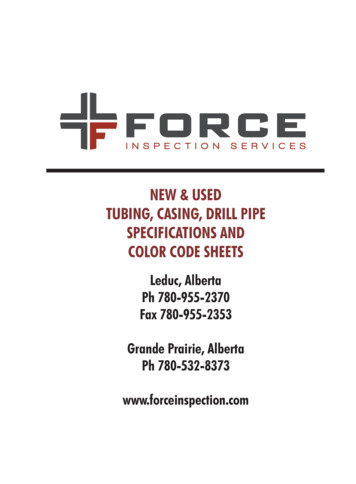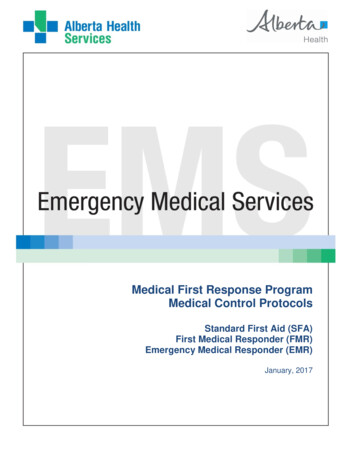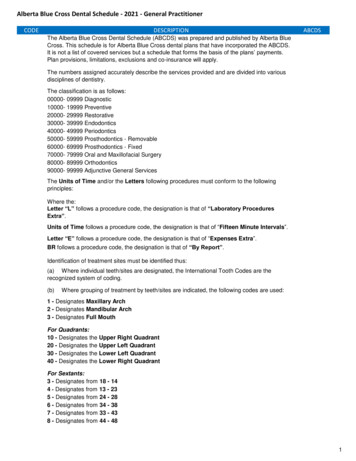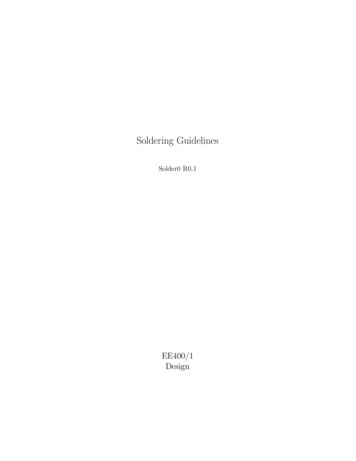
Transcription
Soldering GuidelinesSolder0 R0.1EE400/1Design
Revision HistoryRev.0.1DateSeptember 2005ContributorL. Wyard-Scott0.0January 2004V.J. Sieben, L. WyardScott, E. TiongUpdates to reflect changedCapstone Design Course format and new de/solderingequipment.Creation.
Contents1 Soldering Technique1.1 Required Tools . . . . . . . . . . . . . . . .1.2 Important Soldering Tips . . . . . . . . . .1.3 Precautions . . . . . . . . . . . . . . . . . .1.4 How to Solder Through-Hole Components .1.5 How to Solder Surface-Mount Components1.6 Wire Connectors and Headers . . . . . . . .1.6.1 Crimp Connectors and Pins . . . . .1.6.2 DB Connectors (Solder Cup Type) .1.6.3 Joining Two Wires . . . . . . . . . .1.7 Testing Connections . . . . . . . . . . . . .1.8 Milled Board Soldering . . . . . . . . . . . .1.9 Post-Soldering Cleanup . . . . . . . . . . .1.9.1 PCB Cleanup . . . . . . . . . . . . .1.9.2 Work Area Cleanup . . . . . . . . .2 Desoldering Technique2.1 Solder Pump/Sucker . . . . . . . .2.2 Desoldering Braid/Wick . . . . . .2.3 Desoldering Iron . . . . . . . . . .2.4 Removing Components Effectively.1.1.2.3.4.8.9.9. 10. 10. 11. 12. 12. 12. 12.1313141516.3 Glossary17Bibliography18A Pictures of Tools19i
Chapter 1Soldering TechniqueThis guide is intended to give an introduction to basic soldering technique. Ifthe reader desires to pursue advanced soldering techniques, there are severalbooks as well as technical institutions that offer detailed courses in the areaof soldering.1.1Required ToolsBefore discussing soldering techniques, one should must set up a “solderingwork station”. The following is a list of tools for a typical soldering station.See Appendix A for pictures of the various parts listed below.1. Variable temperature soldering iron: used for applying heat tojoints during the soldering process.2. Damp sponge: for cleaning soldering iron tip.3. Rosin-core solder: to electrically and mechanically bond a component to the PCB.4. Wire cutters or side cutter: for trimming component leads andstripping insulation from wires.5. Needle nose pliers: for holding, placing and shaping components.6. Desoldering pump and/or desoldering braid: for removing solder.7. Scotch tape and/or a “Third Hand”: for securing components.1
Soldering Guidelines (Solder0)1.2 Important Soldering TipsRevision 0.128. Safety glasses: for eye protection. These are mandatory in the lab.9. Magnifier: to provide more detail during intricate work. A magnifying glass is convenient, but an illuminated magnifier is better.10. Light source: to prevent eye-strain.11. Ventilation: to extract and dispel fumes generated during the soldering process.12. Flux: to clean components and PCB pads.13. Acid brush: to assist in the removal of flux residue.Prior to soldering it is a good idea to have all components organizedas it will make populating the PCB more efficient. Make a BOM (bill ofmaterials) for the PCB, and ensure before soldering that the componentshave been collected. The schematic and PCB layout will also be referred towhen populating the board.1.2Important Soldering TipsThe following tips provide a quick guideline on how to make proper joints.Cleanliness: All parts, including the soldering iron tip, must be clean andfree from grease, oxidation and contamination. Solder does not flowover contaminated areas; moreover, solder is repelled by dirt. Severecontamination is evident when solder begins to “bead”. A commonsource of contamination is oxidation. Old components and copperboards will often have an oxide layer that prevents a good solder joint.Ensure all components have shiny leads and the PCB has clean traces.An abrasive such as a blue or pink eraser, emery paper, or stell woolcan be used to remove the oxidized layer from the PCB board andcomponents.Tinning: In addition to being clean, the soldering iron tip must also betinned (coated with solder). Tinning the tip allows solder to flow onthe components more quickly rather than the soldering iron tip itself.Tinning involves adding a few millimetres of solder to the tip andthen wiping and rotating the tip on the damp sponge to reveal a shinysurface on the tip of the soldering iron: a thin layer of solder willcoat or “tin” the tip of the soldering iron. When done soldering,
Soldering Guidelines (Solder0)1.3 PrecautionsRevision 0.13tinning the iron is required to protect the tip from oxidationthereby dramatically increasing its life.Temperature: Ensure that both the component leads and the PCB’s copper layer are heated at the same time. The soldering iron tip shouldcontact both the component and the PCB pad. This will ensure thateach surface is relatively close in temperature resulting in a good joint.If there is a temperature difference between the two surfaces, the solder will form a “dry” joint. Soldering irons are typically set around650 Fahrenheit, depending on the lead-tin ratio of the solder beingused. Too much heat causes excessive “sputtering” of flux, and toolittle doesn’t melt the solder in a timely manner.Duration: The duration that the iron is in contact with the componentand PCB is dependent on the size of the joint and your soldering irontemperature. For the typical PCB through-hole joint, it should take afew seconds to heat the joint and apply the solder. This will requirepractice, so don’t expect to be fast if you are a beginner. Excessive heat(several seconds in duration) will damage sensitive semiconductors. Ifthis is a concern, use a heat sink attached to the component leads:sometimes as simple as an alligator clip. These concerns can sometimesbe avoided by soldering sockets instead of the semiconductor itself.Adequate solder coverage: If too little solder is applied, the joint willnot make a secure connection and will cause erratic behaviour. However, if too much solder is applied, the joint may bridge with adjacentjoints resulting in electrical shorts. How much solder to apply comeswith experience. Figs. 1.4 through 1.7 show good and bad solder joints.Handling: Most modern electronics systems contain static-sensitive devices. Use proper handling procedures to minimize the likelihood ofdamage: grounding wrist-straps, grounded soldering irons, groundingmats, etc.1.3PrecautionsSoldering Irons get very hot (600-800 0 F, 315-4250 C), please ensure you follow precautions during use. Basic safety precautions are listed below. Never leave your iron turned on while unattended.
Soldering Guidelines (Solder0)1.4 How to Solder Through-Hole ComponentsRevision 0.14 Turn the soldering iron off when it is not being used. If the iron is lefton for long periods of idle time, the soldering iron tip will be destroyedthrough oxidation. Eye protection must always be worn when soldering. Hot flux can spitup and into an unprotected eye. In the Capstone Design Lab, useof eye protection is mandatory. If the cord of the soldering iron is damaged, inform the lab staff whowill ensure it is replaced. Never set the soldering iron down on anything other than an ironstand. To prevent burning your fingers, use needle nose pliers, heat resistantgloves, or a third hand tool to hold small pieces. Familiarize yourself with the safe handling of all materials used duringthe soldering process. This includes solder, flux, alcohol, and desoldering braid. Each has a Material Safety Data Sheet (MSDS) and canbe found in the lab or online. “Safe Operating Procedures” are foundposted on the wall close to the soldering facilities.1.4How to Solder Through-Hole ComponentsMost of the soldering done in the Capstone Design Lab is through-hole. Athrough-hole joint is a type of soldering joint in which the component joinswith the PCB pad through a physical hole in the board. The following stepswill illustrate how to make a proper through hole solder joint on a PCB.1. Ensure that the printed circuit board and all components are clean.Cleaning can be achieved with a mild abrasive and/or the applicationof flux.2. Plug in the soldering iron, turn it on, and let it warm up for 2–3minutes.3. Wet the soldering station sponge with the water provided in the lab.Do not wet the sponge in the bathroom or the water fountain.4. Clean the tip of the soldering iron and tin it with solder.
Soldering Guidelines (Solder0)1.4 How to Solder Through-Hole ComponentsRevision 0.155. Insert the component into the holes. Ensure that the component issecure by taping the component or by using a third hand. Optionally,the component leads can be clinched as shown in Fig. 1.1. This technique, however, is not recommended for two-sided boards as the flowof solder to the component side is restricted.Figure 1.1: Clinched Component Leads6. Apply the soldering iron tip to one side of joint making contact withthe component lead and the board copper foil, ensuring that both areheated up to the same temperature as shown in Fig. 1.2 and Fig 1.3.Notice the tinned tip in Fig. 1.3.7. Slowly add a few millimetres of solder to the other side of the joint.DO NOT apply solder to the soldering iron tip. If enough heat wasapplied to the PCB pad and component wire, the solder will flow freelyonto the joint.Figure 1.2: Method of Soldering Through Hole Joints8. Remove the solder when the joint is suitably covered as shown in
Soldering Guidelines (Solder0)1.4 How to Solder Through-Hole ComponentsRevision 0.16Figure 1.3: Method of Soldering Through Hole Joints, [8]Fig. 1.4. The goal is to get the joint to be a “fillet”: a curve as shownin Fig. 1.4.9. If the PCB is double-sided, the solder should flow through the holearound the component lead and make a bond on the component sideof the board (opposite to the side that the solder was applied). If this“wicking” does not occur, the hole may be undersized, clinching couldbe blocking the solder’s path, or the component lead is not clean.10. Remove the soldering iron and allow the joint to cool naturally.Figure 1.4: Good Solder Joint - Solder Fillet11. Cut the lead of the component, if necessary.Fig. 1.6 and Fig. 1.7 below are pictures showing good and bad solderjoints.
Soldering Guidelines (Solder0)1.4 How to Solder Through-Hole ComponentsFigure 1.5: Good Solder Joint, [8]Figure 1.6: Joint Examples, [3]Figure 1.7: Joint Examples, [2]Revision 0.17
Soldering Guidelines (Solder0)1.5 How to Solder Surface-Mount Components1.5Revision 0.18How to Solder Surface-Mount ComponentsSurface mount soldering requires more experience and skill than throughhole. It is recommended that one practices with through-hole prior to attempting any surface mount soldering. As the name suggests, surface mountinvolves soldering a component to either the top or bottom surface of a PCB.Depending on the footprint, the pads are usually a spaced closer together(finer pitch), making the soldering more susceptible to solder bridges, etc.Figs. 1.8 and 1.9 show examples of good surface-mount solder joints.Figure 1.8: Surface Mount Good Solder Joint, [6]Figure 1.9: Surface Mount IC with Good Solder Joints, [5]The actual soldering of the joints is similiar to the through-hole method.One difficulty, however, is maintaining the part’s alignment on the PCBpads. A good technique is outlined here:1. Align the component on the PCB pads. This can be aided with theuse of tweezers and dental picks.2. Secure the component to the PCB by applying a small amount ofpressure onto the top of the component using a small slot screwdriver.
Soldering Guidelines (Solder0)1.6 Wire Connectors and HeadersRevision 0.19An index finger resting on the end of the screwdriver provides enoughforce to secure the device.3. Solder one of the corner component leads to the PCB pad.4. Align the remaining pads and solder the opposite corner PCB pad.5. Solder the remaining pads in a pattern that does not build-up toomuch heat in the device.1.6Wire Connectors and HeadersWhen PCBs are manufactured they often have connectors to peripheraldevices. These connectors are like other components in how they are solderedonto the PCB. However, the plug that matches the connector usually alsorequires some soldering. Please note that with very few exceptions,the wire used for cabling is stranded (rather than solid-core) dueto its higher strength and flexibility. Below are procedures for a fewof the more common plug types.1.6.1Crimp Connectors and Pins1. Strip off about 1cm of the wire insulation.2. Place the exposed wire into the crimp-style connector or pin. The wireshould just barely show coming out the other side. Some crimp pinshave two crimping areas – one for the stripped wire, and the other forthe wire with the insulation.3. Crimp the connector with the appropriate crimping tool. Note thatthe connectors are colour coded to settings on the crimping tool, tryand match the correct colour.4. As added insurance, apply solder to the joint to solidify the connection.Before crimping all pins destined for a connector housing, start with oneand ensure that it fits successfully into the housing. If the crimp is madetoo tightly, or otherwise mis-shaped, the pin may no longer fit.
Soldering Guidelines (Solder0)1.6 Wire Connectors and HeadersRevision 0.110Figure 1.10: Colour Coded Crimp ConnectorsFigure 1.11: Crimp connector without shrink wrap, [1]1.6.2DB Connectors (Solder Cup Type)1. Strip off about 5mm of the wire insulation.2. Tin the wire.3. Slide shrink wrap on the wire.4. Place the wire into the DB - connector solder end.5. Apply the soldering iron tip to the connector and wire.6. Apply a few millimetres of solder until the joint is adequately covered.7. Let the joint cool.8. Slide the shrink wrap over the joint and heat the shrink wrap witha heat gun (or other heat source) until the wrap shrinks around thejoint.1.6.3Joining Two Wires1. Slide shrink wrap on one of the wires.2. Tin or coat each wire with some solder.3. Join the wires in a way that provides a good mechanical connection(such as twisting together) and apply the soldering iron tip and somesolder.
Soldering Guidelines (Solder0)1.7 Testing ConnectionsRevision 0.111Figure 1.12: DB Connector with shrink wrap, [7]4. Let the joint cool.5. Slide shrink wrap over the joint and heat the shrink wrap with aheating gun or a heat source until it the the wrap shrinks around thejoint.Figure 1.13: Two wire joint insulated by shrink wrap, [4]1.7Testing ConnectionsAfter completely soldering a component to a PCB, it is good practice toensure connectivity between the component wire leads and the PCB padsthey are soldered to. A DMM (Digital Multi-Meter) is sufficient to deter-
Soldering Guidelines (Solder0)1.8 Milled Board SolderingRevision 0.112mine connectivity; many DMMs include an audible connectivity setting, butfailing this, measure the joint resistance.1.8Milled Board SolderingIn-lab manufacture of PCBs uses a technique known as “milling”. Themilling technique involves cutting out the PCB tracks and pads from thecopper-clad board.Due to its construction, a milled PCB is susceptible to solder-bridgingacross the milled grooves, particularly when an excess of solder is used.Finding a short caused by a bridge is a difficult task, particularly whenmany solder joints exist. To this end, make a limited number of solderconnections and then test for bridges using a multimeter.1.91.9.1Post-Soldering CleanupPCB CleanupThe flux left behind by rosin-core solders, or perhaps as part of the cleaning process, needs to be removed from the PCB. Due to the flux’s stickynature, dirt gathers and contributes to short-circuiting problems. The mostfrustrating part of this situation is that a short does not necessarily occurimmediately. Weeks, or even years later, a short can develop.To remove flux, alcohol is used. Apply the alcohol liberally and thenbrush away with an acid brush, starting at the center of the PCB andworking out toward the edges. This is a time-consuming task, but a cleanboard is well-worth the effort.1.9.2Work Area CleanupThe importance of keeping your work area clean cannot be emphasizedenough. When clear of obstructions and garbage, handling a hot soldering iron is safer. The soldering process itself involves chemicals and substances which are known to have ill-effects in humans. Wiping-down thework-area surfaces with a moist paper towel will help reduce some contamination. When you are done soldering, wash your hands with soap andwater to get rid of contamination. The primary concern here is accidentalingestion of the chemicals. For more information, please refer to the SafeOperating Procedures, posted in the lab’s soldering area.
Chapter 2Desoldering TechniqueDesoldering may be required for several reasons: a component may have failed a wrong part was installed; a design modification necessitates a change; or if a board contains expensive components that can be salvaged.Whatever the reason, there are three common techniques to remove solder from a joint: using a desoldering pump, a desoldering wick, or desoldering iron.Regardless of the method used, if it is permissible to destroy the partduring removal, then a lot of time and effort can be saved. For instance,using wire cutters to trim off all the pins of a through-hole IC so they canbe removed individually makes the removal process much easier. In mostcases, avoiding damage to the PCB is of paramount importance.2.1Solder Pump/SuckerA desoldering pump is exactly what it sounds like: a pump that sucks up solder. Usually the pump is spring-loaded and provides a recoil when released.The four steps below outline how to desolder a joint using a desolderingpump.1. Prime the desoldering pump. This involves depressing the desolderingpump spring. The pump will click when correctly depressed.13
Soldering Guidelines (Solder0)2.2 Desoldering Braid/WickRevision 0.1142. Heat the joint from one side with the soldering iron tip. Wait 1-2seconds until the solder begins to melt from the soldering iron heat.3. Put the pump tip on the other side of the joint. Don’t be afraid toactually touch the joint.Figure 2.1: Desoldering with a Solder Pump, [8]4. Press the desoldering pump spring-release button to suck up the solder.This procedure should be repeated if the joint has a significant amountof solder. If done correctly the joint should eventually look as shown inFig. 2.2 shown below.Figure 2.2: Clean Joint from Desoldering with a Solder Pump, [8]2.2Desoldering Braid/WickA desoldering braid removes solder from a joint using a technique knownas “wicking”. Desolder braid is a piece of material that sponges up moltensolder by capillary action that draws solder away from the joint the braid.The following procedure outlines the basic steps involved in desoldering ajoint using desoldering braid.
Soldering Guidelines (Solder0)2.3 Desoldering IronRevision 0.1151. Place the desoldering braid over the joint.2. Press the desoldering braid onto the joint with the soldering iron tip.This will apply heat to the desoldering braid and the joint allowingthe molten solder to flow.3. Wait for the solder to melt. The solder should flow onto the braid andaway from the joint.Figure 2.3: Desoldering with a Solder Wick, [8]4. Cut off the solder coated portion of the desoldering braid. Thereshould be no copper visible in the portion that is removed:braid is very expensive.2.3Desoldering IronUsing a desoldering iron, available with higher-end soldering stations, is similar to using a solder sucker. The desoldering iron is essentially a solderingiron with a built-in vacuum.1. Make contact between the iron and the joint to be desoldered, ensuringthe vacuum opening is not blocked.2. Once the solder on the joint has become molten, depress the buttonon the iron to activate the vacuum.It is very important for the life of the desoldering iron that the vacuumassembly be cleaned after every session of use. Please ask the lab personnelfor a description of the cleaning procedure.As with a normal soldering iron, the desoldering iron tip should be tinnedbefore and after every use.
Soldering Guidelines (Solder0)2.4 Removing Components Effectively2.4Revision 0.116Removing Components EffectivelyTo remove a component with little or no damage to the PCB or componenttakes practice and patience. Often when removing a component, PCB padsand tracks may be damaged by “lifting” off the board. Below are some tipsthat may be useful when removing components from a PCB. Desolder all joints pertaining to a component prior to removal. It maybe necessary to go over the joints several times before all the solder isremoved. Practice patience. Use pliers and gently pull on components while applying heat to thejoints. The assistance of a friend can help with this. Do not pull with force, because the PCB pads and tracks will bedamaged. Do not try and remove components by prying them. Do not try to push the component out of the holes with the solderingtip. This will certainly lift the copper pad off of the PCB and ruin theiron tip. In order to get better thermal conductivity between the iron and thesolder joint, it is sometimes effective to add a small amount of solder.
Chapter 3GlossaryBOM: Bill of Materials, which contains a list of all components and valuescontained on a particular PCB. Used as a “shopping list”.Desoldering Braid: A material used to remove solder with capillary action.Desoldering Pump: A device used to remove solder with a swift vacuumaction.Flux: Cleans the surfaces that are being heated by bringing contaminantsto the surface. Most solders include flux in their core. For excessivecontamination use a flux pen.Footprint: The spacing pattern or layout of pads for a particular component or integrated chip, as used on a PCB.PCB (Printed Circuit Board): A fibreglass board upon which coppertraces are laminated to make connections between various components.The copper traces serve as flat wires connecting various components.Shrink Wrap: A tube that fits over a wire, that when heated shrinks toprovide insulation and support for the joints.17
Bibliography[1] R. Glass. Electrical wire soldering for beginners. Technical .[2] D. Lauder.How to solder.Technical report, Oct 2001.http://dragon.herts.ac.uk/ eleqdml/teaching/general/soldering/.[3] W. M. Leach.The leach amp.Technical report,2000.See section on Assembly of Circuit Boards,http://users.ece.gatech.edu/ mleach/lowtim/part2.html.[4] Macroman.Cutting neon alreport.[5] K. Maxon. Have you seen my new soldering iron? Technical 06/oven-art.htm.[6] NIST.Archive of surface evolver .Technical report.[7] t.[8] A. Winstanley.The basic electronics soldering /www.epemag.wimborne.co.uk/solderfaq.htm.18
Appendix APictures of ToolsFigure A.1: Soldering IronFigure A.2: Solder Wire19
Soldering Guidelines (Solder0)Figure A.3: Desolder PumpFigure A.4: Desolder BraidRevision 0.120
Soldering Guidelines (Solder0)Figure A.5: Third ManRevision 0.121
Ensure that the printed circuit board and all components are clean. Cleaning can be achieved with a mild abrasive and/or the application of ux. 2. Plug in the soldering iron, turn it on, and let it warm up for 2{3 minutes. 3. Wet the sol


